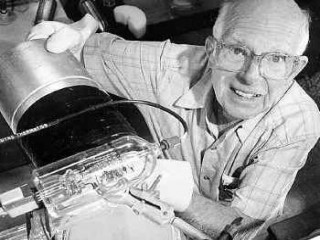
Raymond Davis, Jr. biography
Date of birth : 1914-10-14
Date of death : 2006-05-31
Birthplace : Washington D.C., U.S.
Nationality : American
Category : Science and Technology
Last modified : 2011-12-21
Credited as : scientist, Detected solar neutrinos, Nobel laureate
0 votes so far
American astrochemist Raymond Davis, Jr. was the first scientist to collect neutrinos — tiny, elusive particles emitted from the nuclear-fusion reactions in the core of the Sun, and his work showed that the Sun's heat and fury is caused by the fusion of four protons into helium-4. In 1968 he discovered the solar-neutrino anomaly, wherein the Sun generates energy by nuclear fusion of hydrogen into helium, creating electron-type neutrinos that are changed into other types of neutrinos during their journey from the Sun to the Earth.
Davis reports that he was asked "to find something interesting to work on," and dedicated his career to the study of neutrinos, particles which had been predicted to explain the process of beta decay, but whose separate existence had not been confirmed. Davis investigated the detection of neutrinos by inverse beta decay, the process by which a neutrino brings enough energy to a nucleus to make certain stable isotopes into radioactive ones. Since the rate for this process is very low, the number of radioactive atoms created in neutrino experiments is very small, and Davis began investigating the rates of processes other than inverse beta decay that would mimic the signal of neutrinos.
Using barrels and tanks of carbon tetrachloride as detectors, Davis characterized the rate of the production of Argon as a function of altitude and as a function of depth underground. He deployed a detector containing chlorine atoms at the Brookhaven Reactor in 1954 and later one of the reactors at Savannah River. These experiments failed to detect a surplus of radioactive argon when the reactors were operating over when the reactors were shut down, and this was taken as the first experimental evidence that neutrinos causing the chlorine reaction, and antineutrinos produced in reactors, were distinct.
Detecting neutrinos proved considerably more difficult than not detecting antineutrinos. Davis was the lead scientist behind the Homestake Experiment, the large-scale radiochemical neutrino detector which first detected evidence of neutrinos from the sun.
Davis conducted decades of experiments deep in the Homestake Gold Mine in the Black Hills of South Dakota, where the darkness and distance underground helped shield the neutrino detector from ordinary cosmic rays, which would otherwise obscure any signals caused by neutrino collisions. He shared the 2002 Nobel Prize for Physics with Masatoshi Koshiba, whose work confirmed Davis's findings.
Honours and awards
-Comstock Prize in Physics of the National Academy of Sciences (1978)
-Tom W. Bonner Prize of the American Physical Society (1988)
-W. K. H. Panofsky Prize of the American Physical Society (1992)
-Beatrice M. Tinsley Prize of the American Astronomical Society (1994)
-George Ellery Hale Prize of the American Astronomical Society (1996)
-Wolf Prize in Physics (2000)
-National Medal of Science (2001)
-Nobel Prize in Physics (2002)
-Benjamin Franklin Medal (2003)
















